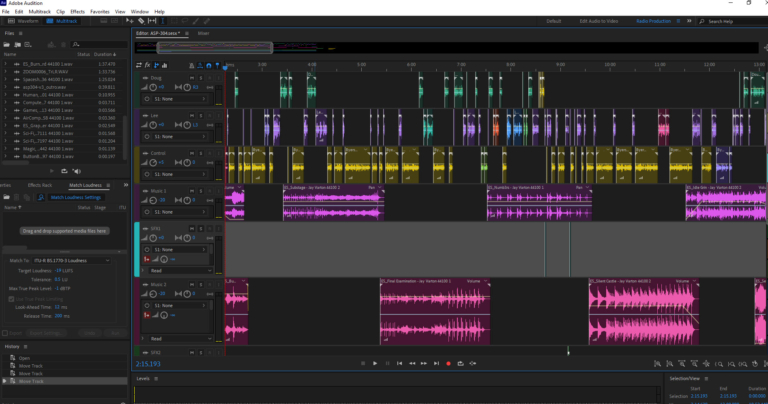Audio editing software is an application that enables users to work with digital audio recordings. These tools offer various features to edit, mix, and improve audio files for different uses, including music production, podcasting, sound design, and audio post-production for video projects.
Different Features of Audio Editing Software
- Waveform Editing: Software visually displays audio waveforms, enabling users to cut, copy, paste, and arrange audio clips with precision.
- Multi-Track Mixing: Most audio programs allow users to work with multiple audio tracks, mixing different audio sources while independently adjusting volumes, panning, and effects.
- Audio Effects and Processing: Users can enhance audio quality or create specific sounds by applying effects such as equalization (EQ), reverb, echo, compression, and noise reduction.
- Recording: Many audio editing applications let users’ record audio from various sources like microphones and line inputs.
- Time Stretching and Pitch Shifting: Users can alter the timing and pitch of audio clips while maintaining audio quality.
- File Format Support: Audio editing software supports various file formats such as WAV, MP3, AAC, FLAC, and others for easy import and export of audio files.
- MIDI Support: Some audio editing software supports MIDI (Musical Instrument Digital Interface), allowing users to work with virtual instruments and MIDI devices.
- Crossfades and Transitions: These tools enable users to create smooth transitions between audio clips, such as crossfades.
Software Applications
These tools offer a range of features such as waveform editing, multitrack mixing, and audio effects, catering to users of all skill levels.
- Adobe Audition:
- Adobe Audition is a high-end audio editing and mixing software that’s part of Adobe Creative Cloud. It is frequently used in broadcast, podcasting, and post-production sectors.
- Audition provides a robust set of audio edit tools, including multitrack mixing, waveform editing, spectral frequency editing, and advanced audio restoration options like noise reduction and de-reverbing. It supports a variety of audio file formats and offers tools for effects, automation, time stretching, and pitch shifting.

- Audacity:
- Audacity is a free, open-source audio editing software popular among hobbyists and professionals. It operates on Windows, macOS, and Linux platforms.
- Audacity offers both basic and advanced audio handling capabilities, including waveform editing, multitrack mixing, and support for various audio file formats.
- It provides built-in effects like equalization and reverb, and features for noise reduction and normalization.

- GarageBand:
- GarageBand is a music production and audio editing software available for macOS and iOS. Known for its ease of use, it appeals to musicians and podcasters.
- GarageBand provides multitrack recording, MIDI, virtual instruments, and a wide array of loops and sounds. It allows users to edit audio easily with functions such as cutting, copying, pasting, and applying effects.

Every audio editing software possesses unique strengths and caters to different needs and levels of expertise. When selecting a software, consider your particular requirements and personal preferences. Whether you are a professional producer, a beginner just starting, or working in fields such as music production, podcasting, or audio post-production, choosing the right software is crucial for achieving the desired results.
See this article to know more about Multimedia Forms: https://www.nucleiotechnologies.com/what-is-multimedia/

